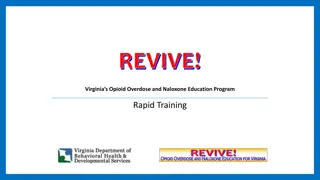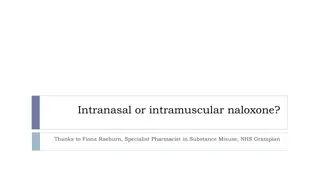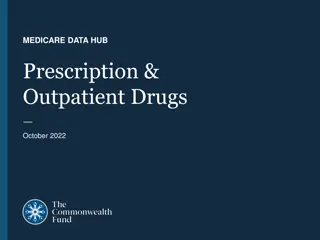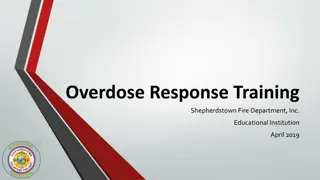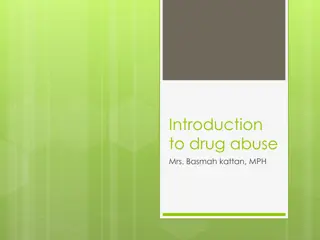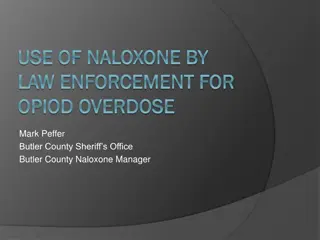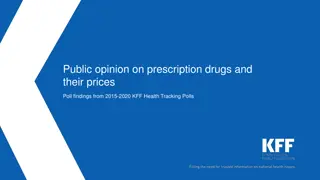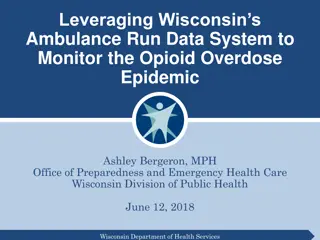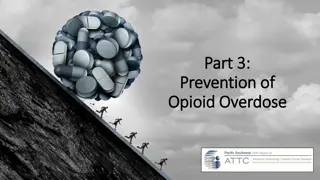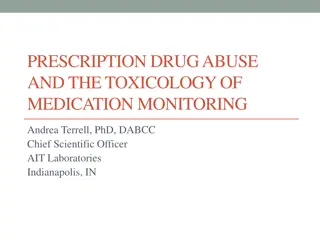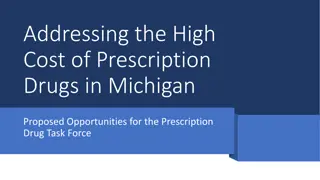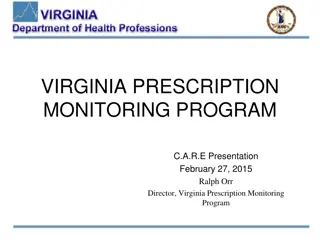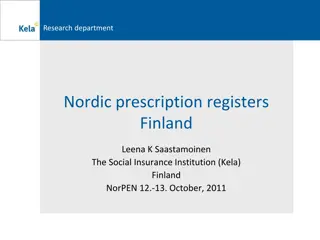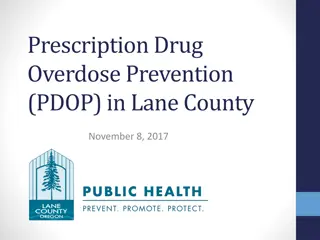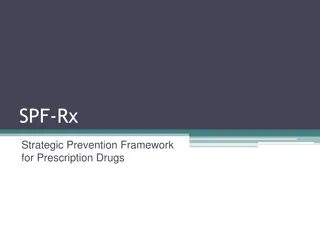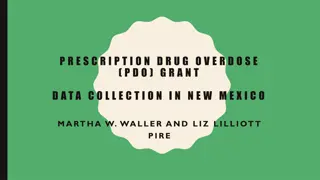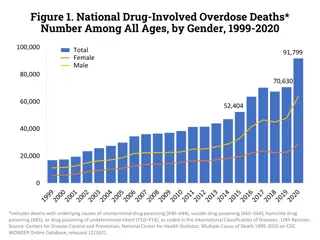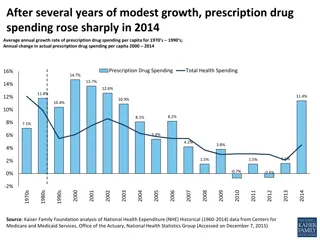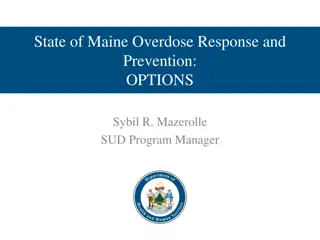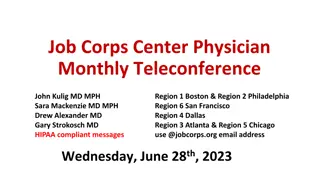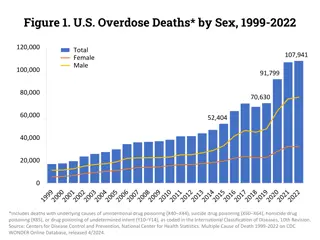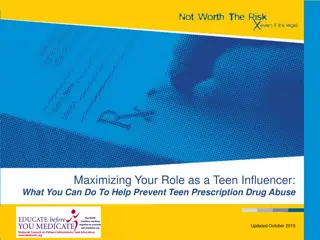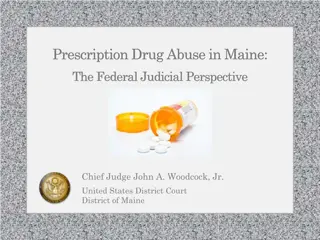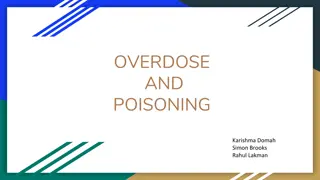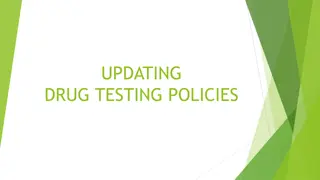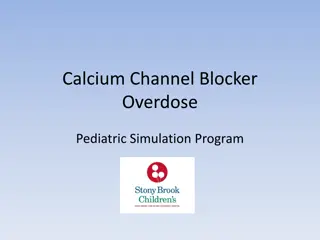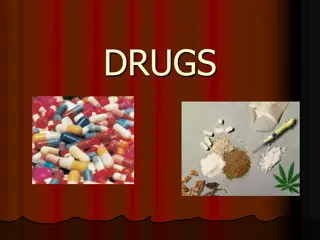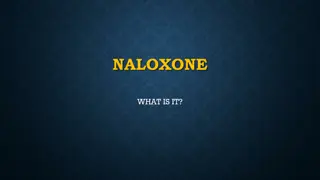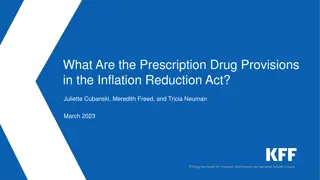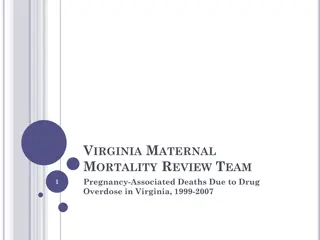Uniform Reporting System for Prescription Drug Price Data Sets Requirements 2024
The Maine Health Data Organization (MHDO) is mandated to collect pricing component data from prescription drug manufacturers, wholesale drug distributors, and pharmacy benefit managers. This data includes information on costs and payments related to making prescription drugs available to consumers.
4 views • 25 slides
2018 Mortality Statistics: Life Expectancy, Drug Overdose, Maternal Mortality Released
Mortality statistics for 2018 were released on January 30, 2020, highlighting life expectancy trends, drug overdose statistics, and the first maternal mortality rate in over a decade. A comprehensive communications strategy was executed to disseminate the data, including a new website, visual abstra
0 views • 9 slides
Understanding Opioid Overdose and Naloxone Education Program in Virginia
The Virginia Opioid Overdose and Naloxone Education Program provide rapid training on opioids, overdose risks, naloxone usage, and emergency response protocols. Opioids include various drugs with potential overdose risk factors such as prior overdoses, reduced tolerance, mixing drugs, and certain me
0 views • 8 slides
Nasal vs Intramuscular Naloxone: A Comparison for Opioid Overdose Response
When administering naloxone for opioid overdose, choosing between nasal spray and intramuscular injection involves considerations such as ease of use, effectiveness in various conditions, and duration of action. Both methods have their advantages and may depend on individual circumstances. Nasal nal
0 views • 11 slides
Medicare Prescription & Outpatient Drugs Data Analysis October 2022
Enrollment in Medicare stand-alone prescription drug plans slightly declined between 2020 and 2021. The rates of enrollment vary between rural and urban states, with higher enrollment in rural states with low Medicare Advantage rates. Across counties, enrollment in prescription drug plans ranges fro
1 views • 13 slides
Understanding Opioid Overdose Response Training
Learn about opioids, recognizing opioid overdose, and responding to emergencies in this educational training by Shepherdstown Fire Department. Get insights on opioid receptors, hierarchy of opioids, chemical anatomy, and factors putting individuals at risk. Equip yourself with the knowledge to admin
0 views • 29 slides
Study on Juvenile Drug Crime Prevention in Taiwan: Insights from ACS Conference 2020
This presentation at the Asian Criminological Society Conference 2020 delves into the current situation, dilemmas, and responses regarding juvenile drug crime prevention in Taiwan. The presenter, Zeng Li-Wen, a PhD student at Central Police University in Taiwan, provides valuable insights based on t
2 views • 20 slides
Understanding Drug Abuse: Definitions, Effects, and Stages
Drug abuse is a serious issue involving various substances like prescription drugs, alcohol, and illegal drugs. This includes terms and definitions, effects on the body and mind, stages of addiction, and withdrawal symptoms. Factors influencing drug action and reasons for drug use are also explored.
5 views • 45 slides
Naloxone Use by Law Enforcement for Opioid Overdose: Importance and Benefits
Naloxone is a critical medication used by law enforcement to reverse opioid overdoses. The Davids Law-Opioid Overdose Reversal Act allows first responders to possess and administer Naloxone. The Good Samaritan Provision provides immunity to those calling for help during an overdose. Naloxone works b
0 views • 36 slides
Public Opinion on Prescription Drugs and Their Prices: Key Findings 2015-2020
Public opinion polls from 2015 to 2020, conducted by KFF Health Tracking Polls, reveal insights on Americans' views on prescription drugs. Key findings include the prevalence of prescription drug use, concerns about affordability, and challenges faced by individuals in affording their medication. Th
2 views • 20 slides
Monitoring Wisconsin's Opioid Overdose Epidemic Through Ambulance Data
Utilizing Wisconsin's Ambulance Run Data System (WARDS), this initiative aims to enhance opioid overdose surveillance by analyzing nonfatal overdose data in real-time. By developing specific case definitions and identifying key variables of interest, the project seeks to improve the timeliness of mo
0 views • 25 slides
Nordic Prescription Registers in Iceland: Overview and Coverage
The Nordic Prescription Registers in Iceland provide detailed data on prescription drug dispensing, covering variables such as drug user information, dispensing details, prescriber data, pharmacy information, and more. The database includes information on all reimbursed and non-reimbursed prescripti
1 views • 11 slides
Understanding Opioid Overdose and Prevention Methods
The World Health Organization defines opioid overdose as a condition that can lead to respiratory depression and death, often identified by pinpoint pupils, unconsciousness, and respiratory depression. The statistics show a concerning rise in opioid-related deaths, emphasizing the urgent need for pr
0 views • 13 slides
Toxicology and Medication Monitoring in Prescription Drug Abuse
Prescription drug abuse is a growing concern, with millions of emergency department visits related to drug misuse or abuse annually. Non-compliance and lack of standardization in testing processes add complexity to monitoring and detecting drug abuse. Pain management panels include various opioids,
0 views • 23 slides
Strategies to Address High Prescription Drug Costs in Michigan
Proposal recommendations for the Prescription Drug Task Force in Michigan include enhancing transparency in cost information, holding stakeholders accountable, improving accessibility to drugs from Canada, ensuring affordability through rate setting and tax credits, and implementing measures to addr
0 views • 6 slides
Virginia Prescription Monitoring Program Overview
The Virginia Prescription Monitoring Program (PMP) aims to track and analyze prescription drug usage to combat substance abuse. Through a comprehensive database, the program helps healthcare providers, law enforcement, and patients access vital information to prevent misuse and overdose deaths. The
0 views • 15 slides
Research Department on Prescription Registers in Finland
Research Department in Finland, led by Leena K. Saastamoinen from The Social Insurance Institution (Kela), focuses on prescription registers and essential demographics, including the size of the population. The department collaborates with relevant institutions and is located in Helsinki. They manag
0 views • 15 slides
Comprehensive Overview of Prescription Drug Overdose Prevention Efforts in Lane County
Efforts in Lane County to prevent prescription drug overdose include forming alliances, organizing educational sessions for prescribers, promoting Naloxone access, and engaging with the community and law enforcement. Initiatives also involve monitoring and addressing risky prescribing practices and
0 views • 13 slides
Prescription Drug Coverage in Medicare Enrollees with Chronic Kidney Disease
This report delves into the sources and parameters of prescription drug coverage in Medicare enrollees with chronic kidney disease (CKD) for the years 2010 to 2015. It explores the trends in Medicare Part D enrollment, out-of-pocket costs, and catastrophic coverage benefits. The data presented sheds
0 views • 20 slides
Strategic Prevention Framework for Prescription Drugs (SPF-Rx)
SPF-Rx is a strategic prevention framework initiated by SAMHSA to address prescription drug abuse, focusing on raising awareness about medication dangers, overprescribing risks, and community prevention activities. The program targets youth aged 12-17 and adults 18+, aiming to combat prescription dr
0 views • 15 slides
Training and Data Collection Tools for Prescription Drug Overdose Grant in New Mexico
This information provides insights into a Prescription Drug Overdose grant program in New Mexico, focusing on training and distributing Naloxone to combat opioid overdose. The program involves a hub and spoke system, where entities like county organizations and local agencies play crucial roles in t
0 views • 22 slides
Prescription Drug and Opioid Misuse in Illinois Epidemiological Profile
Explore the Illinois Statewide Epidemiological Profile on Prescription Drug and Opioid Misuse, developed by the Illinois Statewide Epidemiological Outcomes Workgroup and funded by Substance Abuse and Mental Health Services Administration. The profile covers consumption, prevalence, contributing fact
0 views • 28 slides
Trends in National Drug-Involved Overdose Deaths from 1999-2020
The figures depict the alarming rise in drug-involved overdose deaths in the United States over the period 1999-2020. Figure 1 shows the number of deaths by gender, Figure 2 highlights specific drug categories involved, Figure 3 focuses on opioid-related deaths categorized by gender, and Figure 4 de
0 views • 10 slides
Trends in Prescription Drug Spending and Affordability
Prescription drug spending experienced significant growth in 2014, driven by costly specialty drugs. Medicare emerged as a major payer for prescription medications, with notable increases since 2004. While most individuals can afford their prescription drugs, a significant portion still struggles wi
1 views • 7 slides
Maine Overdose Response and Prevention Program Overview
The State of Maine's Overdose Response and Prevention Program aims to combat substance use disorders through community-based initiatives, public messaging campaigns, and harm reduction strategies. The program includes elements such as community recovery partners, embedded SUD clinicians in first res
0 views • 11 slides
Job Corps Physician Monthly Teleconference and Opioid Overdose Response Guidelines
Job Corps conducts a monthly teleconference for physicians across different regions. Zero new cases of COVID-19 among Job Corps students were reported. Guidelines for responding to opioid overdose in Job Corps include the availability of Narcan kits in various locations and staff training on recogni
0 views • 27 slides
Impact of Socioeconomic Conditions on Drug Use Disorders: Insights from World Drug Report 2020
The World Drug Report 2020 highlights the strong correlation between socioeconomic factors and drug use disorders. Studies reveal that communities facing poverty, violence, and social inequality are at a higher risk of drug overdoses and addiction. Factors like income inequality, lack of social capi
1 views • 17 slides
Understanding Targeted Clinical Investigation in Pharmacovigilance
Targeted clinical investigation plays a crucial role in pharmacovigilance by further evaluating significant risks identified in pre-approval clinical trials. This involves conducting pharmacokinetic and pharmacodynamic studies, genetic testing, interaction studies, and large simplified trials to ass
0 views • 12 slides
Delays in Seeking Help Following Accidental Overdose: Understanding Witnesses' Perspectives
Exploring the reasons behind witnesses delaying help-seeking after an accidental overdose, this study by Katie Hail-Jares delves into incarceration, loss of tolerance, social support systems, and witness behavior. It highlights the challenges of witness reporting in substance use settings and the im
0 views • 19 slides
Opioid Overdose Deaths in the U.S.: Trends and Analysis
The figures illustrate the concerning rise in opioid overdose deaths in the United States from 1999 to 2022. Graphs depict overdose deaths by sex, specific drugs or drug categories, involvement of opioids, and prescription opioids. The data highlights the impact of opioids on both genders and the ro
0 views • 10 slides
Public Opinion on Prescription Drugs and Their Prices: Insights from KFF Health Tracking Polls
Key findings from KFF Health Tracking Polls conducted between 2015-2019 reveal that a significant percentage of Americans face challenges affording prescription drugs despite the widespread use of medication. The survey highlights the impact of costs on medication adherence, showing that many indivi
0 views • 18 slides
Taking a Stand Against Teen Prescription Drug Abuse
Understanding the dangers of teen prescription drug abuse is crucial for young influencers. This workshop equips teens with knowledge on dispelling myths, communicating effectively, and taking an active role in prevention. By recognizing the risks, such as accidental overdose, addiction, and even de
0 views • 36 slides
Federal Judiciary Perspective on Prescription Drug Abuse in Maine
Chief Judge John A. Woodcock, Jr. of the United States District Court in Maine discusses the alarming rates of prescription drug abuse in the state. The consequences of this abuse are highlighted, including the staggering number of pharmaceutical overdose deaths, high school seniors using prescripti
0 views • 34 slides
Comprehensive Guide to Overdose and Poisoning Management
Poisoning and overdose are common occurrences with serious implications. They encompass various toxidromes and require a systematic approach covering risk assessment, resuscitation, investigations, supportive care, decontamination, antidotes, and disposition planning. Recognizing signs of poisoning
0 views • 25 slides
Understanding Drug Testing Policies in the Workplace
The Drug-Free Workplace Act of 1988 mandates federal grant recipients to implement zero-tolerance drug policies to maintain a drug-free environment. Employers must establish clear policies, conduct awareness programs, offer counseling and rehabilitation services, and impose penalties for violations.
0 views • 19 slides
Calcium Channel Blocker Overdose in Pediatrics
Calcium channel blocker overdose is a critical condition that can be life-threatening, especially in children. The overdose can result in symptoms such as syncope, chest pain, weakness, and seizures due to the medication's effects on cardiovascular function. Prompt recognition and appropriate manage
0 views • 14 slides
Understanding Drugs and Their Effects
Drugs, including prescription, over-the-counter, and illegal substances, have various effects on the body and mind. Drug use can lead to addiction, physical dependence, and overdose. It is crucial to distinguish between medicine and drug misuse or abuse to ensure safe and proper usage. Recognizing s
0 views • 25 slides
Understanding Naloxone and Overdose Prevention
Naloxone is a prescription medication used to reverse the effects of opioid drugs and prevent overdose deaths. Available in different forms, Naloxone can be administered by intramuscular injection or intranasal spray. Immediate intervention with Naloxone can save lives by reversing the effects of op
0 views • 8 slides
Overview of Prescription Drug Provisions in Inflation Reduction Act
The Inflation Reduction Act includes significant prescription drug provisions aimed at reducing costs and improving coverage. Key provisions involve government negotiation of drug prices, rebates for price increases, capping out-of-pocket expenses, limiting premium growth, enhancing access to insuli
0 views • 18 slides
Analysis of Pregnancy-Associated Deaths Due to Drug Overdose in Virginia (1999-2007)
This report examines pregnancy-associated deaths in Virginia from 1999 to 2007, specifically focusing on cases related to drug overdose. Among the 397 cases reviewed, substance abuse was found to be a significant contributor to 24.2% of deaths, impacting various causes and manners of death including
0 views • 23 slides


